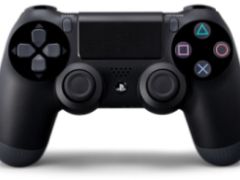Video Gamer is reader-supported. When you buy through links on our site, we may earn an affiliate commission. Prices subject to change. Learn more
Well, this is embarrassing. Not a month after returning from E3 and telling a few friends how I didn’t feel the new PS4 pad was all that, I’ve had to reverse my opinion (I’m off on holiday soon, so I suppose now is probably the right time to get some flip-flops in…).
The catalyst for this about-face was a recent Sony event, held in London so those that didn’t get to E3 could pop in and see what was shown in LA. I wasn’t there to see the games, though, especially when two of the four on display – Killzone and DriveClub – are the sort of titles that seem to hover around the ‘okay’ like your average DDR player.
No, I was there to go hands-on (again) with the pad. Having already pledged my allegiance – or some bollocks like that – to the Xbox One pad, if not the console itself, I wanted to see if my colleagues who liked it have lost their minds.
Turns out they haven’t.
My initial hands-on with the pad had been in a publisher’s booth at E3, where I was ejected after about 7 minutes play because the queue had grown too long outside. Maybe it was the control scheme of the game I was playing – Thief, which post-Dishonored made me feel like I was wrestling a gorilla genetically designed to kill all life on earth – but I just couldn’t get on with it.
Here I was uninterrupted, and my first impressions were proven wrong. I’d never been a fan of the DualShock 3. It felt like a SNES pad with prongs and sticks glued on, which is exactly what it is. As an early adopter of Sony’s third console I also got stung, getting something even worse: the SixAxis. This was a pad that was was so flimsy as to be translucent when held up to light – not a good sign for a system that had Demon’s Souls as an exclusive.
/https://oimg.videogamer.com/images/fa12/8493790392_db910ac4cc_h.jpg)
Despite the fact that it looks positively third-party – the touch pad is as jury-rigged as anything from the A-Team – extended play reveals the DualShock 4 has got a positive heft about it. It’ll have to be thoroughly tested against the PES Rage Scale (which has seen many, better pads go to the big landfill in the sky), but so far it’s looking good.
The analogue sticks have also been adjusted, eliminating the frustrating ‘dead zones’ of the previous model. Microsoft killed Sony in this regard last time out, especially on the shooter front. Requiring so many unnecessary degrees of motion that you’d be more likely to land up in Antarctica than score a headshot, they were unresponsive and poorly implemented.
Said dead zones have been overhauled for this model. The difference this makes to games like Killzone: Shadow Fall is hard to understate, and playing shooters online should now be less of a chore than it previously was. Speaking of the sticks, they’re now concave, meaning that slippage should be less of an issue than before too.
This also applies to the triggers. For reasons known only to Sony’s design team, which I presume was so high on weapons-grade hubris that it decided that designing for actual human hands was too simple, the DualShock 3 triggers were convex, meaning that it was inevitable that your finger would slip from them during frantic moments. No such problems exist here, with the company correcting that oversight.
/https://oimg.videogamer.com/images/0351/8493790598_2828114625_h.jpg)
All told, it feels like the pad is a direct reflection of Sony’s attitude this generation. Last gen it was a swaggering bully which was too busy patting itself on the back to realise that it was making more high-profile mistakes than Rob Green taking goalkeeping advice from a drunk David James. Now, it’s listened, and seems to be giving gamers what they want.
Are there elements that I wish were different? Yes. L2 and R2 still don’t really feel like triggers as they do on the 360 and Xbox One: more buttons with a bit of give to them. Stick placement is also not ideal, for me at least. Again Microsoft’s solution is more satisfying: asymmetrical stick placement is better for those with bigger hands.
As a whole, however, this is a far better offering than what went before. I wasn’t able to test the motion control capabilities of the pad, but the more traditional control solutions work well enough that even if it’s average, or even poor, it shouldn’t matter.
So, sorry, Sony. I was wrong. And sorry to Dave in the pub who I categorically told that it wasn’t as good as he thought it would be.
